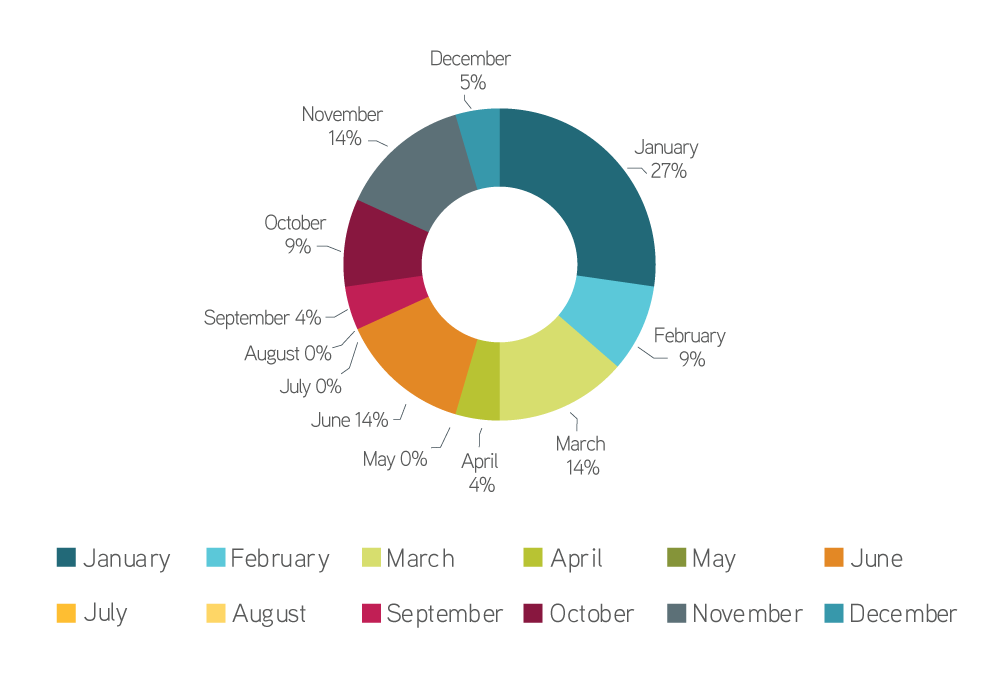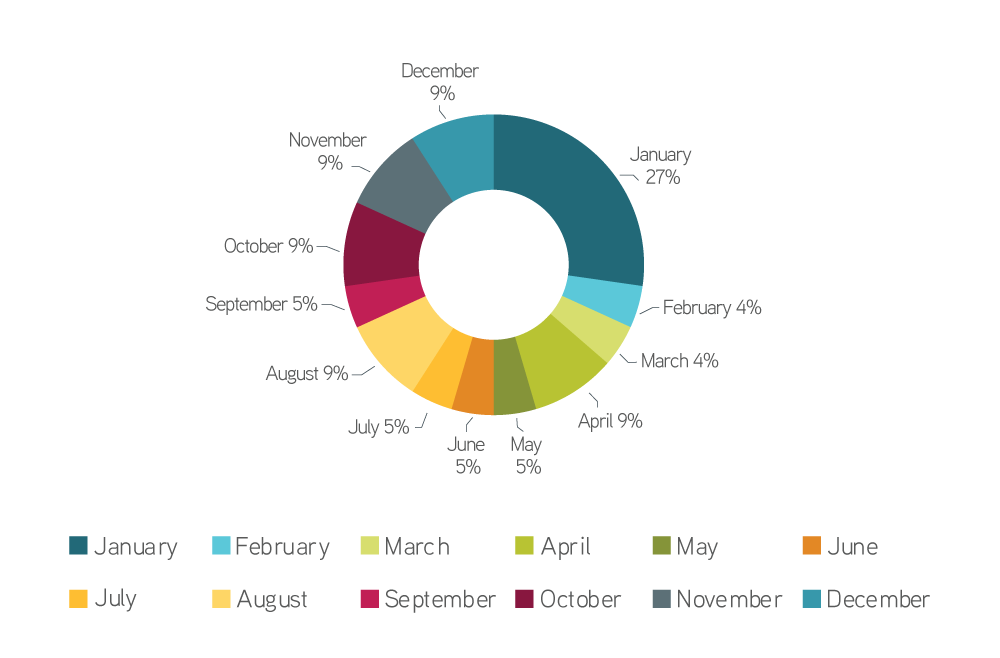By waiting until December to harvest tax losses, investors may be missing out. What opportunities can systematic year-round tax-loss harvesting (TLH) provide?
2023 has offered a welcome reprieve for investors from the significant interest rate increases of the prior year. But investors could still find frequent and meaningful opportunities for TLH. The Federal Reserve’s continued efforts to reduce inflation, paired with the surprisingly resilient US economy, powered interest rates to rise well above the levels at the start of the year. Harvesting losses year-round can significantly reduce income taxes owed on realized gains, keep investors fully invested, and potentially create larger after-tax compounded returns compared with accounts that don’t pursue the strategy.
Bond prices decline when interest rates rise, and this relationship provides opportunities to realize losses. The historic correlation between rising rates and periods of economic strength reasserted itself this year, coinciding with gains in equity prices. This environment presents investors with the opportunity to generate tax-loss assets in fixed income portfolios, potentially reducing the taxes on other portfolio gains now and in the future. Let’s look at the best strategies for TLH that may allow investors to reap valuable tax benefits in a bear market.
Why is it better to harvest tax losses throughout the year?
Systematically harvesting losses over the course of the year can produce a tax asset, or realized losses, that can add considerable alpha to after-tax returns when used to offset realized gains. These strategies are unique to separately managed accounts (SMAs), in which investors directly own the individual securities in their chosen benchmarks. Even if an investor doesn’t have gains to offset in the current year, the tax asset remains indefinitely when investors harvest losses. An added benefit is the opportunity to reinvest at current rates and reset book yields higher.
Advisors typically review their portfolios for TLH trades in December. But doing so in a proactive, systematic manner throughout the year can be much more effective. This is particularly true in fixed income portfolios, where TLH opportunities are mostly driven by changes in interest rates and yearly rate peaks have historically been distributed throughout the calendar year. Investment-grade (IG) corporate bond index yields have only peaked in December on three times over the last 33 years. Municipal index yield peaks have been evenly distributed throughout the year as well, peaking in December only twice in the last 22 years. Systematically monitoring price declines ensures that maximum losses are realized no matter when they occur. Spreading the trades throughout the year also avoids the poor liquidity conditions that generally occur late in the year. This year we’ve already found many opportunities to harvest losses for our clients.
Corporate yield peaks by month

Source: Bloomberg Municipal Bond Index, 9/28/2023. For illustrative purposes only. Not a recommendation to buy or sell any security. It is not possible to invest directly in an index. Indexes are unmanaged and do not reflect the deduction of fees or expenses.
Municipal yield peaks by month

Source: Bloomberg US Corporate Bond Index, 9/28/2023. For illustrative purposes only. Not a recommendation to buy or sell any security. It is not possible to invest directly in an index. Indexes are unmanaged and do not reflect the deduction of fees or expenses.
Manage taxes systematically all year
What should investors consider when choosing a TLH strategy?
TLH strategies are a long-standing practice in equity portfolios, but implementing these strategies efficiently at scale in fixed income is a relatively new development. Wide bid-ask spreads and liquidity considerations have historically precluded efficient execution. Electronic trading has dramatically decreased corporate and municipal bid-ask spreads over the last several years. Managers can further reduce transaction costs by aggregating large blocks of bonds from many SMAs to produce large institutional-sized trading positions. In addition, Parametric’s proprietary technology allows us to analyze client portfolios continuously, identifying greater numbers of TLH opportunities and ensuring that losses are realized during rate peaks, potentially resulting in optimized sales timing and reduced cash drag. Turnover numbers for many SMA investors have been notably higher than in previous years due to the extreme number of TLH opportunities. Advisors should consider applying TLH with a rules-based approach that accounts for each sector’s unique tax treatment and liquidity characteristics.
We periodically work with individual financial advisors and clients looking to recognize specific TLH opportunities in their portfolios. However, we encourage investors to consider using systematic and ongoing TLH whenever available. The economies of execution and scale, the ability to execute trades throughout the year, and the after-tax alpha potential of this systematic approach are significant.
Financial advisors should evaluate trades in terms of:
- Thinking of the transaction risk and potential changes to the portfolio’s risk characteristics
- Calibrating trade execution filters to ensure that the tax benefit of the trade is sufficient to cover its transaction cost
- Maintaining the account’s appropriate duration, credit quality, and yield
- Keeping corporate bond and municipal bond ladders program procedures in compliance with wash-sale rules
How can investors create unique opportunities from volatility?
Parametric’s municipal portfolio managers executed over 300,000 TLH trades in 2022, representing $17 billion in par value. We generated similar results for IG corporate bond ladder accounts, where ladder traders executed over 12,000 trades representing $1.1 billion in par value.
This year has been different. With yields mildly higher across the municipal and corporate bond market, we’ve seen fewer opportunities to harvest losses. Year-to-date performance in fixed income markets is up or down about 1%, according to Bloomberg. Yields have still shown periods of sharp volatility, as illustrated in the chart below, but nowhere near as dramatically as in 2022. Despite less overall opportunity, we’re still actively harvesting losses for clients this year. As of the end of 2022, we will have been able to harvest $250 million in losses for our clients across our SMAs.1
1 Source: Parametric, 9/30/2023. The information is provided for illustrative purposes only. Values are aggregated across all municipal laddered strategies, managed municipal strategies, and municipal total return strategies. Only client positions with unverified cost basis were excluded from calculations. Loss calculation is based on the amortized book price minus the sell price, represents historical information, and should not be construed as future results. Loss information illustrates the effect to a portfolio and is not representative of and should not be construed as performance. There is no assurance that tax-loss harvesting will continue in the future. There is no guarantee that any specific account may engage in tax-loss harvesting.
Yield to worst, as of September 28, 2023

Source: Bloomberg, 9/28/2023. For illustrative purposes only. Not a recommendation to buy or sell any security. It is not possible to invest directly in an index. Indexes are unmanaged and do not reflect the deduction of fees or expenses.
The bottom line
In light of this year’s rate volatility, we’ve taken advantage of the opportunity to generate value for our clients in the form of tax alpha. As we enter the fourth quarter of 2023, we’ll continue to actively seek improved after-tax performance through our tax management capabilities.
Investment strategies that seek to enhance after-tax performance may be unable to fully realize strategic gains or harvest losses due to various factors. Market conditions may limit the ability to generate tax losses. Tax-loss harvesting involves the risks that the new investment could perform worse than the original investment and that transaction costs could offset the tax benefit. Also, a tax-managed strategy may cause a client portfolio to hold a security in order to achieve more favorable tax treatment or to sell a security in order to create tax losses. Prospective investors should consult with a tax or legal advisor before making any investment decision.

















